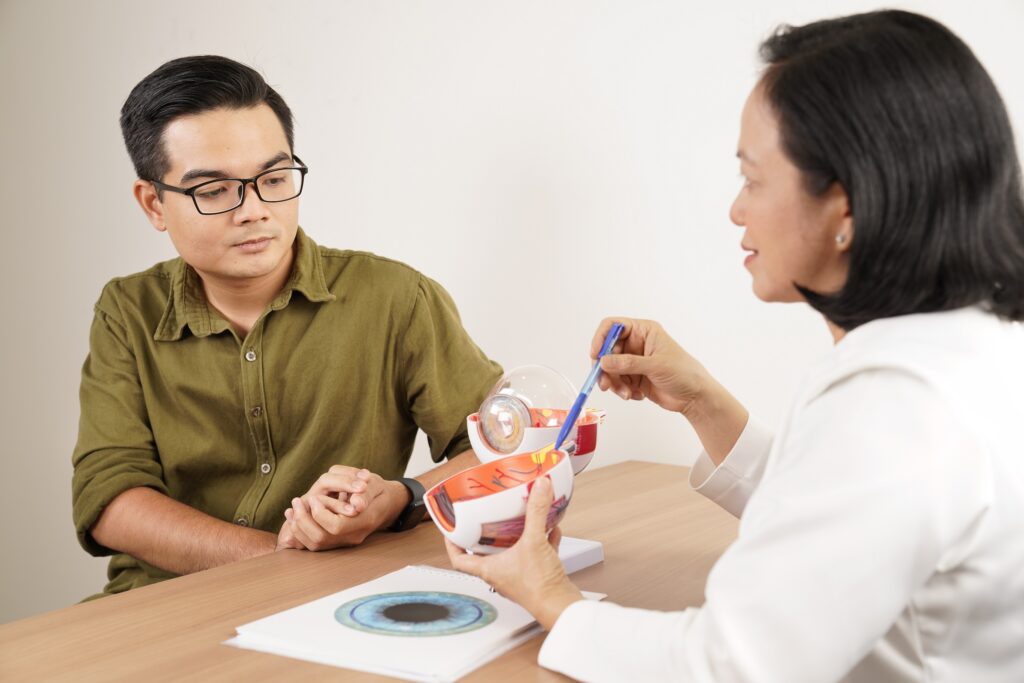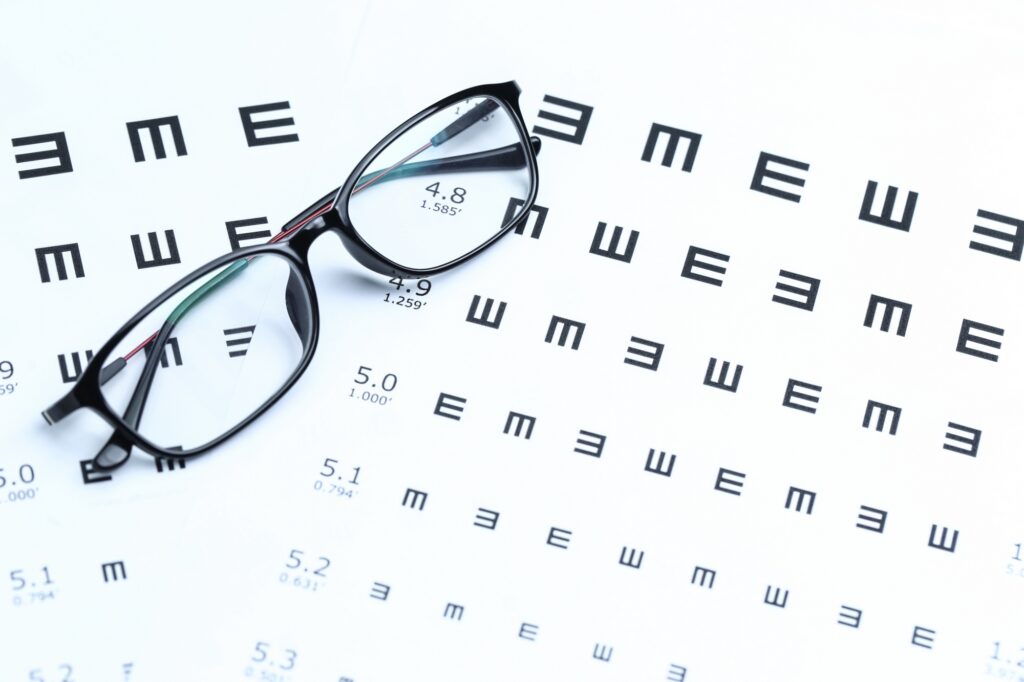
Prima Medical Center Saigon, Refractive and Lasik
Visual acuity: Is “20/20” perfect vision?
19 February, 2024

Dr Thao Vo, CMO @ Prima Saigon, is consultating a young patient about refraction problem
If you have an eye exam and are told you have 20/20 perfect vision, does this mean you have perfect eyesight? Is it possible to achieve even better than 20/20 vision? And what is “perfect vision” anyway?
To answer these questions, let’s take a closer look at vision-related terminology to fully understand how eye doctors measure the quality of your vision.
Visual acuity, eyesight and vision: What’s the difference perfect vision?
Visual acuity. This, literally, is the sharpness of your vision. Visual acuity is measured by your ability to identify letters or numbers on a standardized eye chart from a specific viewing distance .
It is a static measurement, meaning you are sitting still during the testing and the letters or numbers you are viewing also are stationary, it is also tested under high contrast conditions — typically, the letters or numbers on the eye chart are black, and the background of the chart is white.
Although visual acuity testing is very useful to determine the relative clarity of your eyesight in standardized conditions, it isn’t predictive of the quality of your vision in all situations. For example, it can’t predict how well you would see:
Objects that are similar in brightness to their background
Colored objects
Moving objectsThree major physical and neurological factors determine visual acuity:
- How accurately the cornea and lens of the eye focus light onto the retina
- The sensitivity of the nerves in the retina and vision centers in the brain
- The ability of the brain to interpret information received from the eyes
Only light that is focused on a very small and highly sensitive portion of the central retina (called the macula) influences visual acuity measurements obtained during an eye exam.
- Eyesight. The exact definition of “eyesight” is difficult to pin down. Depending on which dictionary or other resource you check, it can mean “ability to see,” “the sense of seeing,” “vision,” “range of sight” or “view.” Often, the terms “eyesight” and “visual acuity” are used interchangeably.
- Vision. This is a broader term than visual acuity or eyesight. In addition to sharpness of sight or simply a description of the ability to see, the term “vision” usually includes a wider range of visual abilities and skills. These include contrast sensitivity, the ability to track moving objects with smooth and accurate eye movements, color vision, depth perception, focusing speed and accuracy, and more.
If this more inclusive (and accurate) definition of “vision” is used, what most people call “20/20 vision” should really be called “20/20 visual acuity.” Realistically, that probably won’t happen. For better or worse, the term “20/20 vision” is likely here to stay.
What is 20/20 vision?
The term “20/20” and similar fractions (such as 20/40, 20/60, etc.) are visual acuity measurements. They also are called Snellen fractions, named after Herman Snellen, the Dutch ophthalmologist who developed this measurement system in 1862.
In the Snellen visual acuity system, the top number of the Snellen fraction is the viewing distance between the patient and the eye chart. This distance typically is 20 feet in the United States, ; in other countries, it is 6 meters.

Prima Saigon Eye Hospital: It’s nearly impossible to quantify what “perfect” vision is. A more interesting question is, “Perfect for what?”
At this testing distance, the size of the letters on one of the smaller lines near the bottom of the eye chart has been standardized to correspond to “normal” visual acuity — this is the “20/20” line. If you can identify the letters on this line but none smaller, you have normal (20/20) visual acuity.
The increasingly larger letter sizes on the lines on the Snellen chart above the 20/20 line correspond to worse visual acuity measurements (20/40, 20/60, etc.); the lines with smaller letters below the 20/20 line on the chart correspond to visual acuity measurements that are even better than 20/20 vision (e.g., 20/15, 20/12, 20/10).
The single big “E” at the top of most Snellen eye charts corresponds to 20/200 visual acuity. If this is the smallest letter size you can discern with your best corrective lenses in front of your eyes, you are legally blind.
On most Snellen charts, the smallest letters correspond to 20/10 visual acuity. If you have 20/10 visual acuity, your eyesight is twice as sharp as that of a person with normal (20/20) vision.
Yes, it’s indeed possible to have sharper than 20/20 vision.
In fact, most people with young, healthy eyes are capable of identifying at least some of the letters on the 20/15 line or even smaller letters on the Snellen chart.
This may be due in part to better printing methods available today vs. those in the 19th century when Snellen was determining the smallest letters a person with normal vision should be able to discern. So a case could be made that “normal” visual acuity today is an ability to identify letters that are a bit smaller than those on the 20/20 line of a traditional Snellen eye chart.
On the other hand, people are living longer today than they did in Snellen’s era. Normal aging changes in the eye, such as early cataracts, could justify considering somewhat larger letters than those on the 20/20 line as being indicative of “normal” vision among adults in their 60s or older.
Regardless of these considerations, let’s say your eye doctor says you have 20/20 vision (or, more accurately, 20/20 visual acuity), and you want sharper eyesight.
What can you do?
If your 20/20 vision doesn’t seem sharp enough, it could be that your eyes have higher-order aberrations (HOAs) that cannot be corrected with regular eyeglasses or soft contact lenses. Your eye doctor can check for these aberrations with wavefront technology that is available in some eye care practices.
If HOAs are caused by small irregularities in the shape of the front surface of your eyes, being fitted with gas permeable contact lenses (GP lenses) often can improve your visual acuity better than eyeglasses or soft contact lenses. This is because GP lenses are rigid and essentially replace the eye’s irregular front surface with a perfectly smooth, curved surface to focus light more accurately.
Another option might be custom wavefront LASIK. This personalized laser vision correction surgery can provide vision that is comparable to wearing rigid gas permeable contact lenses (which often is sharper than the visual acuity provided by glasses or soft contact lenses), without the hassle of the daily contact lens care.
If you prefer to wear eyeglasses to correct your refractive errors, glasses with special high-definition lenses might give you sharper vision than regular eyeglass lenses.
What is “perfect” vision?
It’s nearly impossible to quantify what “perfect” vision is. A more interesting question is, “Perfect for what?”
For example, if you are driving on a sunny day, excellent Snellen visual acuity might be the main factor in your satisfaction with your vision. But your traveling companion, who has worse visual acuity than yours, might be happier with her vision in the same circumstances because she is wearing polarized sunglasses with anti-reflective coating that enhance contrast and block glare.
Or an athlete who has better than 20/20 vision might struggle with his performance because he doesn’t have certain dynamic visual skills that allow him to react to moving objects as quickly as a teammate whose static visual acuity isn’t as sharp as his.
See the Eye doctor Prima Saigon Eye Hospital
The first step to maximizing the clarity and comfort of your eyesight in all situations is to see a qualified optometrist or ophthalmologist for a comprehensive eye exam and vision evaluation.
If you are interested in finding out if laser vision correction could sharpen your vision better than glasses or contacts, ask to be referred to an experienced LASIK surgeon for a consultation.
If you want to maximize your dynamic vision skills for sports and other activities, seek an eye doctor who is a sports vision specialist and ask about sports vision training.
Finally, if your child has 20/20 vision but is struggling with eye strain and other vision problems in school, seek the advice of an eye care provider who specializes in children’s vision to have your child evaluated for possible learning-related vision problems.
Dr THAO Vo, Chief Medical Officer , Prima Saigon Eye Hospital
If you need an eye assessment, please have a visit to Prima Saigon Eye Hospital
- Address: 27 Ky Dong St, District 3, HCMC
- Website: https://primahealth.vn/en/
- Business Hours: 07:30 – 17:00 from Monday – Saturday
- HOTLINE: 0919-209-039 or 1900 – 9115
Prima Saigon Eye Hospital recommends that clients should reserve their intended consultation at least three days before their visit for convenience and less waiting time.

Dr Thao Vo, CMO @ Prima Saigon, is consultating a young patient about refraction problem
If you have an eye exam and are told you have 20/20 perfect vision, does this mean you have perfect eyesight? Is it possible to achieve even better than 20/20 vision? And what is “perfect vision” anyway?
To answer these questions, let’s take a closer look at vision-related terminology to fully understand how eye doctors measure the quality of your vision.
Visual acuity, eyesight and vision: What’s the difference perfect vision?
Visual acuity. This, literally, is the sharpness of your vision. Visual acuity is measured by your ability to identify letters or numbers on a standardized eye chart from a specific viewing distance .
It is a static measurement, meaning you are sitting still during the testing and the letters or numbers you are viewing also are stationary, it is also tested under high contrast conditions — typically, the letters or numbers on the eye chart are black, and the background of the chart is white.
Although visual acuity testing is very useful to determine the relative clarity of your eyesight in standardized conditions, it isn’t predictive of the quality of your vision in all situations. For example, it can’t predict how well you would see:
Objects that are similar in brightness to their background
Colored objects
Moving objectsThree major physical and neurological factors determine visual acuity:
- How accurately the cornea and lens of the eye focus light onto the retina
- The sensitivity of the nerves in the retina and vision centers in the brain
- The ability of the brain to interpret information received from the eyes
Only light that is focused on a very small and highly sensitive portion of the central retina (called the macula) influences visual acuity measurements obtained during an eye exam.
- Eyesight. The exact definition of “eyesight” is difficult to pin down. Depending on which dictionary or other resource you check, it can mean “ability to see,” “the sense of seeing,” “vision,” “range of sight” or “view.” Often, the terms “eyesight” and “visual acuity” are used interchangeably.
- Vision. This is a broader term than visual acuity or eyesight. In addition to sharpness of sight or simply a description of the ability to see, the term “vision” usually includes a wider range of visual abilities and skills. These include contrast sensitivity, the ability to track moving objects with smooth and accurate eye movements, color vision, depth perception, focusing speed and accuracy, and more.
If this more inclusive (and accurate) definition of “vision” is used, what most people call “20/20 vision” should really be called “20/20 visual acuity.” Realistically, that probably won’t happen. For better or worse, the term “20/20 vision” is likely here to stay.
What is 20/20 vision?
The term “20/20” and similar fractions (such as 20/40, 20/60, etc.) are visual acuity measurements. They also are called Snellen fractions, named after Herman Snellen, the Dutch ophthalmologist who developed this measurement system in 1862.
In the Snellen visual acuity system, the top number of the Snellen fraction is the viewing distance between the patient and the eye chart. This distance typically is 20 feet in the United States, ; in other countries, it is 6 meters.

Prima Saigon Eye Hospital: It’s nearly impossible to quantify what “perfect” vision is. A more interesting question is, “Perfect for what?”
At this testing distance, the size of the letters on one of the smaller lines near the bottom of the eye chart has been standardized to correspond to “normal” visual acuity — this is the “20/20” line. If you can identify the letters on this line but none smaller, you have normal (20/20) visual acuity.
The increasingly larger letter sizes on the lines on the Snellen chart above the 20/20 line correspond to worse visual acuity measurements (20/40, 20/60, etc.); the lines with smaller letters below the 20/20 line on the chart correspond to visual acuity measurements that are even better than 20/20 vision (e.g., 20/15, 20/12, 20/10).
The single big “E” at the top of most Snellen eye charts corresponds to 20/200 visual acuity. If this is the smallest letter size you can discern with your best corrective lenses in front of your eyes, you are legally blind.
On most Snellen charts, the smallest letters correspond to 20/10 visual acuity. If you have 20/10 visual acuity, your eyesight is twice as sharp as that of a person with normal (20/20) vision.
Yes, it’s indeed possible to have sharper than 20/20 vision.
In fact, most people with young, healthy eyes are capable of identifying at least some of the letters on the 20/15 line or even smaller letters on the Snellen chart.
This may be due in part to better printing methods available today vs. those in the 19th century when Snellen was determining the smallest letters a person with normal vision should be able to discern. So a case could be made that “normal” visual acuity today is an ability to identify letters that are a bit smaller than those on the 20/20 line of a traditional Snellen eye chart.
On the other hand, people are living longer today than they did in Snellen’s era. Normal aging changes in the eye, such as early cataracts, could justify considering somewhat larger letters than those on the 20/20 line as being indicative of “normal” vision among adults in their 60s or older.
Regardless of these considerations, let’s say your eye doctor says you have 20/20 vision (or, more accurately, 20/20 visual acuity), and you want sharper eyesight.
What can you do?
If your 20/20 vision doesn’t seem sharp enough, it could be that your eyes have higher-order aberrations (HOAs) that cannot be corrected with regular eyeglasses or soft contact lenses. Your eye doctor can check for these aberrations with wavefront technology that is available in some eye care practices.
If HOAs are caused by small irregularities in the shape of the front surface of your eyes, being fitted with gas permeable contact lenses (GP lenses) often can improve your visual acuity better than eyeglasses or soft contact lenses. This is because GP lenses are rigid and essentially replace the eye’s irregular front surface with a perfectly smooth, curved surface to focus light more accurately.
Another option might be custom wavefront LASIK. This personalized laser vision correction surgery can provide vision that is comparable to wearing rigid gas permeable contact lenses (which often is sharper than the visual acuity provided by glasses or soft contact lenses), without the hassle of the daily contact lens care.
If you prefer to wear eyeglasses to correct your refractive errors, glasses with special high-definition lenses might give you sharper vision than regular eyeglass lenses.
What is “perfect” vision?
It’s nearly impossible to quantify what “perfect” vision is. A more interesting question is, “Perfect for what?”
For example, if you are driving on a sunny day, excellent Snellen visual acuity might be the main factor in your satisfaction with your vision. But your traveling companion, who has worse visual acuity than yours, might be happier with her vision in the same circumstances because she is wearing polarized sunglasses with anti-reflective coating that enhance contrast and block glare.
Or an athlete who has better than 20/20 vision might struggle with his performance because he doesn’t have certain dynamic visual skills that allow him to react to moving objects as quickly as a teammate whose static visual acuity isn’t as sharp as his.
See the Eye doctor Prima Saigon Eye Hospital
The first step to maximizing the clarity and comfort of your eyesight in all situations is to see a qualified optometrist or ophthalmologist for a comprehensive eye exam and vision evaluation.
If you are interested in finding out if laser vision correction could sharpen your vision better than glasses or contacts, ask to be referred to an experienced LASIK surgeon for a consultation.
If you want to maximize your dynamic vision skills for sports and other activities, seek an eye doctor who is a sports vision specialist and ask about sports vision training.
Finally, if your child has 20/20 vision but is struggling with eye strain and other vision problems in school, seek the advice of an eye care provider who specializes in children’s vision to have your child evaluated for possible learning-related vision problems.
Dr THAO Vo, Chief Medical Officer , Prima Saigon Eye Hospital
If you need an eye assessment, please have a visit to Prima Saigon Eye Hospital
- Address: 27 Ky Dong St, District 3, HCMC
- Website: https://primahealth.vn/en/
- Business Hours: 07:30 – 17:00 from Monday – Saturday
- HOTLINE: 0919-209-039 or 1900 – 9115
Prima Saigon Eye Hospital recommends that clients should reserve their intended consultation at least three days before their visit for convenience and less waiting time.



